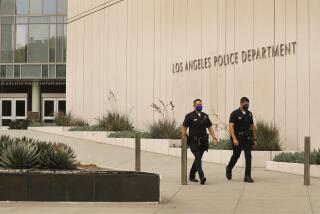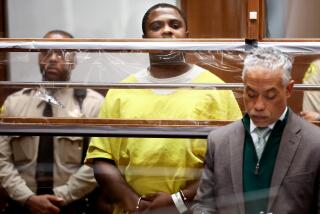Suspect’s blog was the net that snared him
For a generation, LAPD homicide investigators kept alive the case of 28-year-old Japanese tourist Kazumi Miura, shot in the head on a featureless side street in the shadow of a Los Angeles urban icon: downtown’s four-level freeway interchange.
For nearly three decades, they pursued her husband, Kazuyoshi, for the 1981 crime. But he remained beyond their reach, as Japanese authorities tried and convicted him of murder, only to see the case overturned.
When the break finally came last week, it was the result of Miura’s own Internet-fed self-promotion: a personal blog.
Since 2005, police had been monitoring postings by Miura, who had become an outsized Japanese personality because of media coverage of his alleged crimes.
On one website, Miura promotes himself as a human-rights advocate who helps those falsely accused of crimes. He also publicizes his book and a DVD about his case and holds gatherings featuring alleged victims of wrongful prosecution and other guests, whom he charges about $30 to attend.
In postings last year, police said, he mentioned international travel plans, including a possible trip to Saipan, a U.S. territory and popular tourist destination north of Guam.
Retired LAPD Lt. Jimmy Sakoda, who worked with Japanese authorities during their prosecution of Miura, had maintained contacts with his international counterparts, according to Det. Rick Jackson of the LAPD’s Cold Case Homicide Unit.
After Sakoda gave Jackson a heads up about Miura’s travel plans, detectives alerted Immigration and Customs officials in Saipan to be on the lookout.
They apparently missed his arrival, but immigration agents on the island nabbed Miura, now 60, last Friday when he attempted to leave for Japan.
“It was just a matter of wait and see,” Jackson said of the final push to catch Miura, “if he left [Japan], and whether things would work out with our liaisons in other countries.”
Miura, who has repeatedly denied involvement in his wife’s murder, is awaiting extradition to Los Angeles.
LAPD detectives say they have a strong circumstantial case, built on evidence they helped prepare for the prosecution that initially succeeded in Japanese courts. The arrest and trial to come will bring the long, twisting saga -- a Japanese version of the O.J. Simpson case, featuring allegations of a hit man, a conspiracy with a former adult actress and a $650,000 life insurance policy -- back to where it began, and back into the media eye.
At Los Angeles police headquarters Thursday, detectives were briefing a Japanese television team on the case. Twelve more camera crews waited in the lobby.
It was about noon in the fall of 1981, Kazuyoshi Miura said, and he was snapping photos of his young wife Kazumi on Fremont Avenue, beside the Harbor Freeway, when she fell to the pavement, apparently shot in the head. He said that as he ran to her, he felt his left thigh burning and realized he also had been hit.
Then a stylish, ocean-hopping importer, Miura claimed that two men in their mid-20s appeared and casually rifled his pockets and his wife’s purse, taking $1,200 before driving off in a large, dark green older car. “Without any contact or asking, they just started to shoot,” Miura told a Times reporter from his hospital bed the next day. “To do this, just for $1,000. What is this all about?”
He blamed America’s culture of violence and said he would write protest letters to the president, the governor and the mayor. “Many Japanese will be coming to the U.S. with a dream on their hearts. I strongly hope this accident will never occur again,” he told one group of reporters.
The .22-caliber round that struck Kazumi left her in a coma for a year. The U.S. Air Force flew her back to Japan, where she died in November 1982.
At first, Kazumi’s death appeared to make the case that no one was safe in Los Angeles, then struggling to control drug and gang violence. But as L.A. police and Japanese reporters dug deeper, darker details began to emerge. There had been an attempt on her life three months before she was shot.
Miura had allegedly plotted with a former Japanese adult-film actress, who came to Los Angeles and pretended to be a seamstress. The actress, Michiko Yazawa, visited Kazumi in her room and struck her in the head with a hammer.
Yazawa, who claimed to be Kazuyoshi’s mistress, later told authorities she could not go through with the killing and fled.
Then-Dist. Atty. Ira Reiner said at the time that Yazawa also told authorities she rejected another murder plan almost identical to the one that resulted in Kazumi’s death. That plot called for her to drive up to Miura and his wife and shoot them both -- her in the head and him in the leg.
By 1985, Yazawa’s confessions had eroded sympathy for Miura in Japan, where the law says attacks on citizens on foreign soil can be prosecuted at home.
Yazawa was convicted of the attempted murder in a Tokyo court in 1986 and sentenced to 2 1/2 years. A year later, Miura also was convicted of the attempted murder and sentenced to six years in prison.
Meanwhile, back in Los Angeles, Reiner announced in 1988 that his office would prosecute Miura for his wife’s murder. He said the circumstantial evidence would include the testimony of a girlfriend who served as an accomplice in the earlier attempted murder.
In an interview this week, Reiner said that Sakoda, the retired LAPD investigator who headed the department’s Asian organized crime team, should be credited with keeping the case going. After leaving the Police Department, he joined the district attorney’s office as an investigator.
“Everyone in the LAPD initially believed the robbery story,” Reiner recalled. “Jimmy never did. He was relentless.”
The motive for the murder, according to Los Angeles County prosecutors, was Miura’s desire to collect $655,000 in life insurance on his wife.
Though Miura claimed attackers jumped out of a big green car, witnesses at the nearby Department of Water and Power building overlooking the shooting scene said the attackers were in a white van.
Other witnesses came forward to claim that Miura had offered them money to kill his wife, authorities said.
Los Angeles prosecutors ultimately deferred to Japanese authorities, who charged Miura with murder in 1988.
Authorities there alleged that Miura was driven by greed and had tried to exploit Japanese fears about Los Angeles. Named as Miura’s accomplice in the shooting was a man who acted as an interpreter when a Times reporter interviewed Miura in his hospital bed the day after the shooting.
Miura was convicted in the case, but the accomplice was not. The failure to convict the accomplice led a Japanese appeals court to overturn Miura’s murder conviction in 1998.
Adding to the intrigue, Miura was identified by Reiner as a suspect in another murder case, though he was never charged. In March 1984, authorities identified the corpse of woman found in a field five years earlier.
She was Chizuko Shiraishi, 34, who Miura reportedly acknowledged to Japanese reporters was once his business associate and lover.
The LAPD this week said that case remains unsolved.
The reversal of Miura’s murder conviction in Japan could have ended the story. At one time, trying Miura again in the U.S. would have violated the constitutional ban on double jeopardy.
But in 2004, California lawmakers removed the double jeopardy protection for those put on trial overseas after Los Angeles County Sheriff’s Deputy David March was shot and killed in 2002 by a foreign national who later fled to Mexico.
That opened the door for Miura to be prosecuted in the United States, according to Los Angeles officials. Japan, however, wouldn’t extradite him to the U.S. because he had already faced a trial for the murder, LAPD officials said.
Miura might never have had to face the charges again but for his blogging, police said.
“In the end, it was his own words that came back to bite him,” said Jackson’s partner, Det. Richard Bengston.
--
--
richard.winton@latimes.com
--
rich.connell@latimes.com
--
Times staff writer Teresa Watanabe contributed to this report.
More to Read
Start your day right
Sign up for Essential California for news, features and recommendations from the L.A. Times and beyond in your inbox six days a week.
You may occasionally receive promotional content from the Los Angeles Times.







